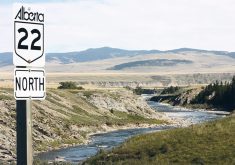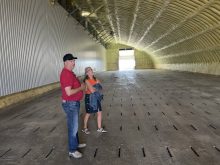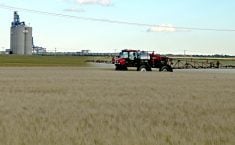Experts predict the day is coming when feed grain producers will be just as happy to see a restaurant customer select the cedar plank salmon dish as the peppercorn sauce rib eye.
Farmed fish now account for an estimated 45 percent of the fish available for human consumption. One-quarter of them are filter feeders that eat plants and insects found in the ponds where they are raised.
The rest are raised on pelleted food, a growing percentage of which contains large amounts of vegetable protein.
The emerging aquafeed industry has created a huge market for a variety of grain, oilseed and pulse crops almost overnight, similar to what happened with the emergence of biofuel.
Read Also

New coal mine proposal met with old concerns
A smaller version of the previously rejected Grassy Mountain coal mine project in Crowsnest Pass is back on the table, and the Livingstone Landowners Group continues to voice concerns about the environmental risks.
“It’s a very rapidly growing sector and they need lots of protein, so I’d say the sky is the limit,” said Murray Drew, an aquaculture specialist at the University of Saskatchewan.
The growth of this new livestock industry is particularly remarkable considering it was almost non-existent until the early 1970s.
“By 2010 the production of aquaculture products is going to exceed the production of beef in the world,” Drew said.
Global production has grown from less than a million tonnes in the early 1950s to 48 million tonnes by 2005, according to the latest figures available from the United Nations Food and Agriculture Organization (FAO). The value was $78.4 billion US.
Most of the growth occurred in the last 20 years as the harvest from overfished oceans struggled to keep pace with an ever-expanding global population with a growing appetite for seafood.
Accompanying the shortage of wild fish for human consumption are stagnant stocks of “trash fish,” low-value species such as sardines, herrings and anchovies that are ground into fishmeal, a product that until recently was the primary source of feed for the aquaculture industry.
Concerns are rising about the sustainability of converting low-value fish species into high-value species. There are also concerns surrounding dioxins, PCBs and chemicals found in trash fish.
Compounding the environmental worries is the economic reality that the explosive growth of the farmed fish population has pressured fishmeal supplies and driven up the cost of a product that accounts for 40 to 60 percent of the total costs of an intensive aquaculture farm.
Since 1985, global fishmeal production has stabilized at six to seven million tonnes a year, a situation the FAO has dubbed “the fishmeal trap.”
“This means that the expanding aquaculture and livestock sectors will be competing for a resource that is not increasing,” said the FAO in its State of World Aquaculture 2006 report.
That opened the door for alternative protein sources, and it swung wide in 2006 when fishmeal prices doubled.
Experts predict there will soon be a lot more businesses like Can Pro Ingredients Ltd., a Saskatchewan company building a $15 million plant in Arborfield, Sask., to produce a canola-based fish feed.
The company is using technology developed by MCN BioProducts Inc. to fractionate the oilseed into a protein concentrate destined for the aquaculture industry and fibre and carbohydrate components for other feed uses.
Its potent concentrate will contain 65 percent protein, about the same as fishmeal. Can Pro president Todd Lahti said he expects the facility will produce 7,000 tonnes of the product annually starting next spring, with plans to triple that over the next three years.
Soybean meal and corn gluten have made substantial inroads in feed formulations, but the inclusion rates in fish feed are limited by antinutritional factors such as fibre, sugar and starch that are foreign to fish and can cause myriad digestion and palatability problems.
By fractionating crops into their components, manufacturers can substantially boost protein levels while removing the undesirable material.
“The meals and the seeds are inadequate in their current form and there is only so much you can do with genetics,” Lahti said. “With processing you can very quickly resolve meal composition problems.”
Ron Hardy, director of the Aquaculture Research Institute at the University of Idaho and one of North America’s leading aquaculture experts, agreed that making protein concentrates from a variety of crops is the way to go.
“I’ve been preaching this for a long time,” he said. “We don’t have room in the formulations to throw in all this less refined stuff and still reach the targets of protein and fat levels we want to see.”
Fractionation used to be cost-prohibitive, but with advancing technology and soaring fishmeal prices, vegetable protein concentrates have become competitive. Hardy said large companies such as Cargill and Archer Daniels Midland are dabbling in the technology.
There will still be room for soybean meal, corn gluten and other basic feed ingredients in the diets of carp, catfish, tilapia and other omnivorous fish that require lower protein levels, but concentrates will some day dominate the diets of salmon, trout, cod and other high-value carnivorous species of farmed fish.
Hardy estimated there will soon be a three million tonne shortfall of fishmeal, perhaps growing to seven million tonnes by 2025 as the aquaculture industry grows and vegetable protein manufacturers learn how to better replace some of the essential ingredients found in fishmeal.
To put it in perspective, that much protein concentrate would require 30 million tonnes of soybeans, which is 42 percent of this year’s expected U.S. crop, or more canola than Canada can produce in a year.
Hardy expects to see more crop fractionation plants sprouting across North America to meet that burgeoning demand, many of them built in conjunction with ethanol and biodiesel facilities. He says it makes good economic sense to divide a crop into its components before fermentation, using the protein for the feed industry and the starch for biofuel production.
Lahti said governments are unlikely to financially support biofuel forever, and when the subsidies end the plants must learn to stand on their own.
“They’re going to need a greater margin contribution from the nonoil side of the business,” he said.
He anticipates more canola meal will be processed in the near future because more of it will be available once crushers expand to meet growing biodiesel demand, creating the opportunity for a synergistic relationship with a company such as Can Pro.
A study that helped pave the way for the U of S’s new Feed Technology Research Facility predicted the aquaculture industry could result in six new multimillion-dollar processing plants in Saskatchewan alone, making dehulled flax, flax oil concentrate, canola protein concentrate and pea protein concentrate.
Can Pro will be the first plant on the Prairies to make a protein concentrate specifically targeted to the aquaculture market. Lahti is excited about the long-term potential of such plants and the potential benefit for western Canadian grain farmers.
“Just doing some quick math, if we were to capture 10 percent of the fishmeal market, that would be about 600,000 tonnes of protein concentrate or 1.8 million tonnes of meal or three million tonnes of canola seed,” he said.
That is one-third of this year’s expected canola crop.

















